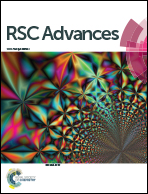A colorimetric and ratiometric fluorescent pH probe based on ring opening/closing approach and its applications in monitoring cellular pH change†
Abstract
A colorimetric and ratiometric fluorescent pH probe with a pKa value of 6.0 based on a ring opening/closing approach of N,O-disubstituted hemiaminal ether has been developed. The probe exhibits fast response toward pH change with high selectivity and low cytotoxicity and was applied in HK-1 cells to visualize pH change.


 Please wait while we load your content...
Please wait while we load your content...